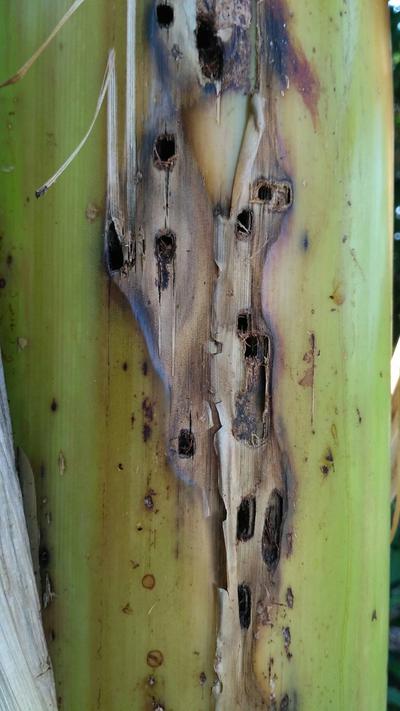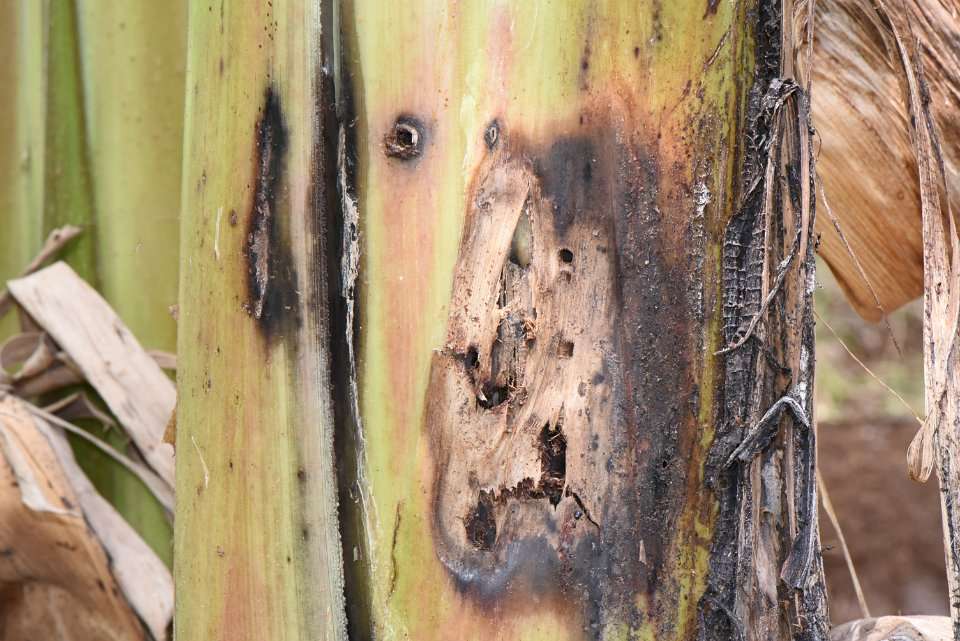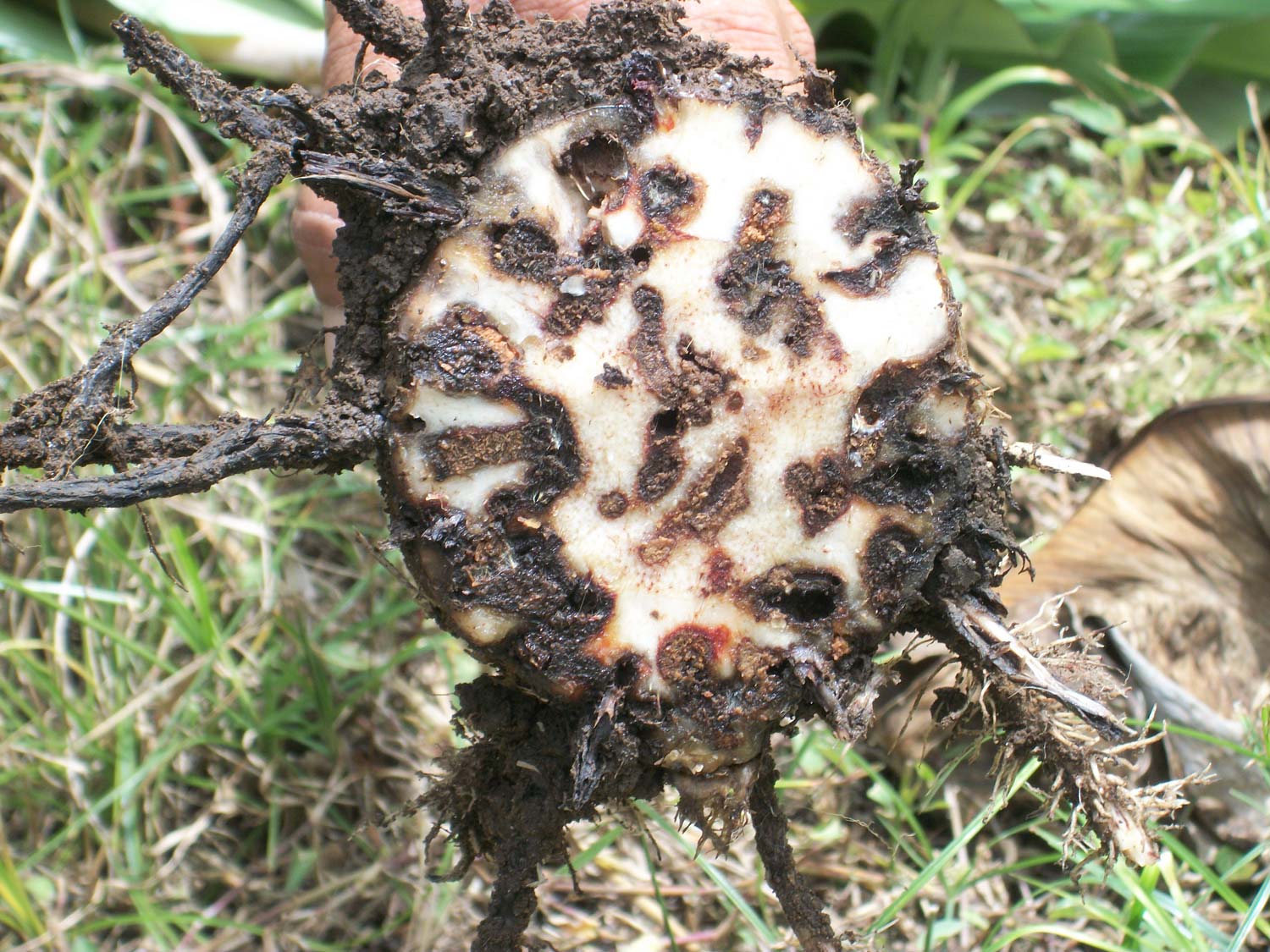
Black banana weevil
Cosmopolites sordidus
Pathogène :
Insect
Type:
Risque:
CRITICAL
Picudos



QUI EN EST LA CAUSE ?
Cosmopolites sordidus, known as the black banana weevil, is a beetle of the Curculionidae family that mainly attacks banana trees. Adults are black or dark brown insects, with an elongated body and a characteristic elongated face. They are nocturnal and hide during the day at the base of the pseudostem or in nearby plant remains. Females deposit eggs in small holes made at the base of the pseudostem or in exposed roots. After hatching, the larvae, with a whitish body and no legs, begin to feed on the internal tissue of the plant, excavating galleries that weaken its structure. The larval phase is the most destructive and can last several weeks before the larvae transform into pupae within cavities inside the stem. Finally, adults emerge, which can live for several months and restart the reproductive process. Due to its cryptic behavior and its ability to passively disperse through the transport of infected plant material, it is a difficult pest to eradicate.
SYMPTÔMES
The banana tree infested by the black weevil experiences a progressive decrease in its vigor due to the internal destruction of its tissues. The formation of galleries in the pseudostem compromises the stability of the plant, increasing the risk of overturning. In addition, internal wounds caused by the larvae facilitate the entry of secondary pathogens, which aggravates the damage.
- Holes at the base of the pseudostem with dark exudates.
- Progressive wilting of the lower leaves.
- Reduced growth and lower fruit production.
- Pseudostem weakened and prone to fracture.
- Presence of larvae and galleries inside the stem.
- Premature death of the plant in severe infestations.
TEMPÉRATURE ET HUMIDITÉ
24°C - 30°C
75% - 90%
VOIES DE TRANSMISSION
Movement of contaminated plant material, soil adhered to tools or machinery, passive dispersal by wind, active movement of adults in the crop
TRAITEMENTS
Traitements chimiques
• HUILE D'ORANGE 60g/L [ME] P/S
• PHOSTIAZATE 15% [CE] P/V
• LAMBDA CYHALOTHRINE 10 % [CS] P/V
• SPINOSAD 48 % [SC] P/V
Traitements autorisés en agriculture biologique
• HUILE D'ORANGE 60g/L [ME] P/S
• LAMBDA CYHALOTHRINE 10 % [CS] P/V
• SPINOSAD 48 % [SC] P/V
Traitements biologiques
• BEAUVERIA BASSIANA (souche NPP111B005) 5x10E8 ufc/g [MG] P/P
Recommandations
- Use certified pest-free planting material to avoid the introduction of the black weevil in new plantations.
- Implement sanitation practices by eliminating plant residues and infested plants to reduce the presence of the insect.
- Apply pheromone traps to monitor the population and reduce the number of adults.
- Promote the presence of natural enemies such as entomopathogenic nematodes and fungi such as Beauveria bassiana for biological control.
- Carry out treatments with specific insecticides following integrated pest management strategies to avoid the accumulation of resistance.
- Avoid overexploitation of crops and carry out rotations to reduce the incidence of the pest.
- Disinfect agricultural tools and equipment to prevent the spread of the black weevil between plots.
- Apply physical barriers such as plastic traps or materials that prevent adult access to the base of the pseudostem.
TRAITEMENTS
Remèdes maison
There are no home treatments
Alliés naturels
Traitements chimiques
There are no treatments for this disease. Treatments are directed at the insect vectors that transmit it. See insect treatments.
RECOMMANDATIONS
- Check the back of the leaves frequently, especially in dry weather.
- Spray water on the leaves to increase humidity and prevent them from settling.
- Keep plants healthy with good watering and adequate light.
- If you see cobwebs or damage, clean the leaves with a damp cloth or pressurized water.
- Use potassium soap or neem oil every few days until they disappear.
Plantes répulsives
Rosemary, Dill, Coriander
PRODUITS RECOMMANDÉS
*Les traitements recommandés sont des recommandations basées sur les bases de données des autorités et ne remplacent en aucun cas les lignes directrices établies par la législation de chaque pays.
*Les produits présentés sont des recommandations et ne sont pas nos propres produits. En tant qu'associés Amazon, nous gagnons des revenus grâce aux achats de produits recommandés.





















